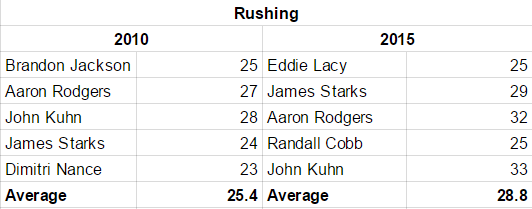2015 and 2010: So What's the Difference?
It's easy to compare the 2015 Packers and the 2010 Packers. Both were 10-6. Both were perceived to have underachieved. Both finished second in the NFC North behind relatively strong defenses and relatively inconsistent offenses, at least at times.
The 2010 Packers went on to win the Super Bowl, so the easy assumption is that the 2015 squad will do the same. But will they?
I don't think so, but I'm becoming less sure that this year's team is really markedly different from 2010. Speaking broadly, my general consensus about this year's team is that some of the key contributors are a little on the old side and some of the players who find themselves more on the young side aren't really pulling their weight.
The initial data wouldn't necessarily seem to bear that out. The average ages of both the 2010 and 2015 Packers' starting lineups is almost the same, at just over 27. The average ages of the rosters as a whole is pretty close too: the 2010 team averaged out at just over 26 years old, while the 2015 team is just under that point.
However, the similarities break down when you delve into exactly who did what for both teams. For instance, here's a look at the average ages of the top five rushers by yardage for both 2010 and 2015:
As you can see, the Super Bowl champion Packers relied on a much younger stable of backs than this year's team. 28.8 isn't terribly ancient for running backs, but 28 or so is about when runners start to head downhill, and three of the Packers' five most successful rushers this year are past that point.
Oddly, the Packers have the exact reverse problem when it comes to their pass catchers:
The Packers' receivers this year are just over a year and a half younger than their 2010 counterparts, but I bet you'd take the 2010 crop over this year's group in a heartbeat, right? While younger and presumably springier, the Packers' receiving corps this year was underwhelming to say the least.
These same two problems hold true for almost every other area on the two teams. Here's a quick look at the age differences between the leaders for tackles, sacks, and interceptions:
The 2015 Packers were either younger and less effective or older and less productive than their 2010 counterparts. Even though, as I said earlier, the average ages between the two teams' starting lineups and overall rosters are about the same, the 2010 Packers really had it where it counts: they got consistency from their young performers (a la James Starks in the playoffs) and they got the solid, leadership-style performances from their older players.
This entire phenomenon leads me to believe that the Packers are far closer to a full teardown and rebuild than we might want to believe.
Logically, the younger players presently on the Packers roster (think about the surprisingly successful and youthful secondary) will need a couple more years of seasoning before they really become team leaders. That ads a couple more years to the Packers core...which is surprisingly long in the tooth.
Julius Peppers, Aaron Rodgers, Clay Matthews, B.J. Raji, Josh Sitton, T.J. Lang, and Sam Shields are all 28 years old or older. How many years of contention does that group really have left? Two, if we're lucky?
My point, in all of this, is that no matter how this weekend's game goes, bear in mind that we may be seeing the end of an era. The Packers may be ready for a reshuffling, and it'll be incumbent upon Ted Thompson to give the roster a reworking in the offseason to make the best use of whatever remains of Aaron Rodgers' prime.






